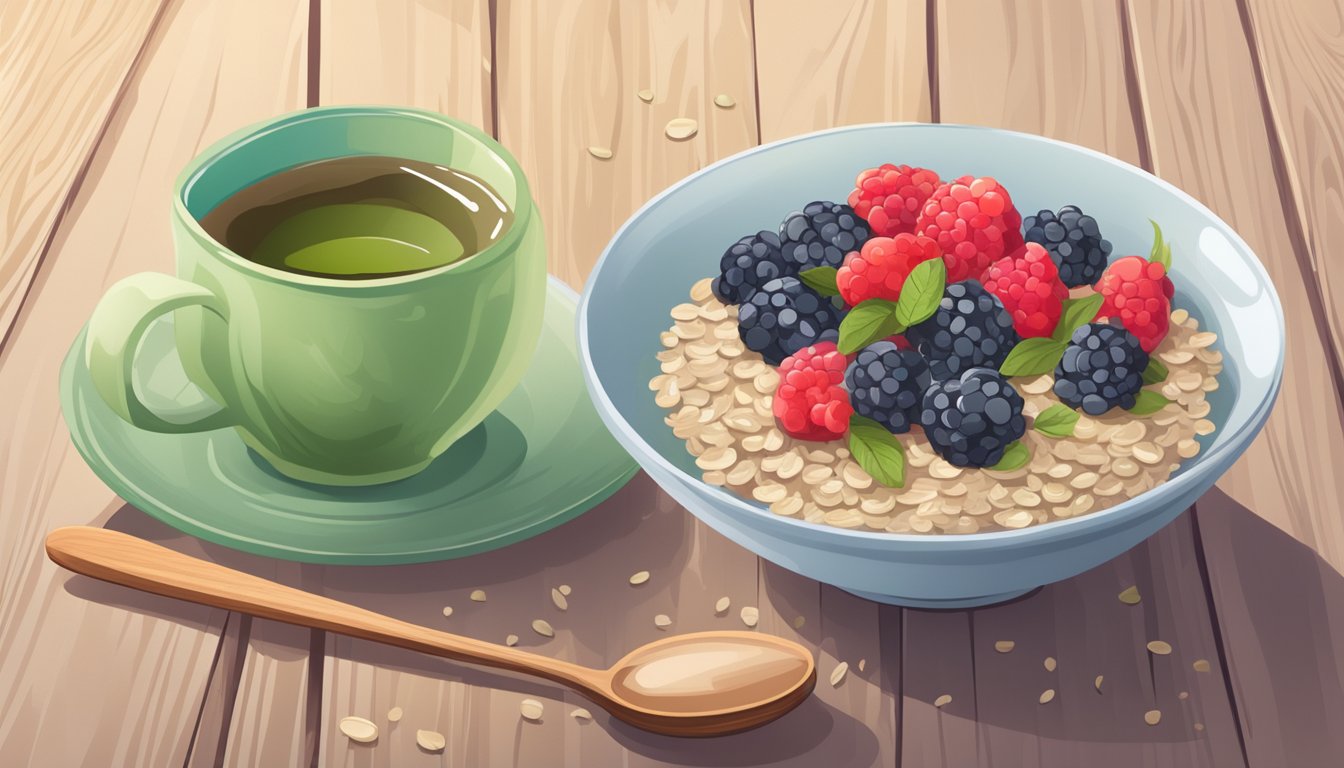Breakfast is often called the most important meal of the day, and for good reason. Starting your morning with the right foods can set you up for successful weight loss efforts. Choosing nutrient-dense, protein-rich options like eggs, Greek yogurt, oatmeal, and fruits can help control hunger and reduce overall calorie intake throughout the day.
Eating a balanced breakfast with lean proteins, fiber, and healthy fats provides sustained energy and promotes feelings of fullness. This can prevent overeating and unhealthy snacking later on. Some excellent breakfast choices for weight loss include vegetable omelets, whole grain toast with avocado, or Greek yogurt parfaits topped with berries and nuts.
Portion control is key when it comes to breakfast for weight loss. Even nutritious foods can hinder progress if consumed in excess. Aim for a moderate-sized meal that satisfies hunger without overdoing it on calories. Pairing protein sources with high-fiber fruits or vegetables creates a winning combination to support weight management goals while nourishing the body.
Understanding Weight Loss and Breakfast
Breakfast plays a crucial role in weight management by influencing metabolism and food choices throughout the day. A well-balanced morning meal provides essential nutrients and helps control hunger.
The Role of Breakfast in Weight Management
Eating breakfast jumpstarts metabolism after the overnight fast. This boost in metabolic rate helps burn more calories throughout the day. A nutritious breakfast also stabilizes blood sugar levels, reducing cravings and overeating later.
Studies show that regular breakfast eaters tend to maintain a healthier weight. They often consume fewer calories overall and make better food choices. Skipping breakfast, on the other hand, can lead to increased hunger and poor dietary decisions.
A protein-rich breakfast is particularly effective for weight loss. It increases satiety and helps preserve lean muscle mass during calorie restriction. Fiber-rich options also promote fullness and improve digestion.
Nutritional Composition of a Weight Loss Breakfast
A weight loss breakfast should include lean protein, complex carbohydrates, and healthy fats. Protein sources like eggs, Greek yogurt, or lean meats help build and repair tissues. They also keep you feeling full longer.
Whole grains provide fiber and sustained energy. Oatmeal, whole grain toast, or quinoa are excellent choices. Fresh fruits and vegetables add vitamins, minerals, and antioxidants to the meal.
Healthy fats from sources like avocados, nuts, or seeds support hormone production and nutrient absorption. They also contribute to meal satisfaction.
A balanced breakfast might include:
- 2 scrambled eggs
- 1 slice whole grain toast
- 1/4 avocado
- 1 small apple
This combination provides protein, complex carbs, healthy fats, and fiber to support weight loss efforts and overall health.
Key Nutrients for a Healthy Breakfast
A nutritious breakfast supports weight loss by providing essential nutrients that fuel the body and promote satiety. Focusing on protein, fiber, healthy fats, vitamins, and minerals can create a balanced morning meal.
Protein-Rich Foods for Sustained Energy
Protein is crucial for building and repairing tissues, as well as promoting fullness. Eggs are an excellent source of high-quality protein. Greek yogurt offers a protein punch along with beneficial probiotics. Lean meats like turkey or chicken breast can be incorporated into breakfast sandwiches or wraps. Plant-based options include tofu, tempeh, and legumes such as lentils or chickpeas.
For those preferring a quick meal, protein powders can be added to smoothies or oatmeal. Cottage cheese is another protein-rich option that pairs well with fruits or whole-grain toast.
A protein-rich breakfast helps stabilize blood sugar levels and reduces cravings throughout the day. Aim for 15-25 grams of protein at breakfast for optimal benefits.
Fiber-Packed Options for Fullness
Fiber aids in digestion, promotes feelings of fullness, and supports a healthy gut microbiome. Whole grains like oatmeal, quinoa, and whole wheat bread are excellent sources of fiber. Chia seeds and flaxseeds can be easily added to yogurt, smoothies, or cereal for a fiber boost.
Fruits such as berries, apples, and pears provide both soluble and insoluble fiber. Vegetables like spinach, kale, and bell peppers can be incorporated into omelets or breakfast burritos.
Aim for 5-10 grams of fiber at breakfast. Gradually increase fiber intake to avoid digestive discomfort. Pair fiber-rich foods with adequate water intake for optimal digestion.
Healthy Fats to Support Metabolism
Healthy fats are essential for hormone production and nutrient absorption. Avocados are rich in monounsaturated fats and can be spread on toast or added to smoothies. Nuts and seeds, such as almonds, walnuts, and pumpkin seeds, provide healthy fats along with protein and fiber.
Nut butters like almond or peanut butter can be spread on whole-grain toast or added to oatmeal. Olive oil can be used for cooking eggs or drizzled over avocado toast.
Fatty fish like salmon or sardines offer omega-3 fatty acids, which support brain health and reduce inflammation. Include a serving of healthy fats to promote satiety and support overall metabolic health.
Vitamins and Minerals for Overall Well-Being
A nutrient-dense breakfast should include a variety of vitamins and minerals. Fruits and vegetables are packed with essential nutrients. Berries are high in antioxidants and vitamin C. Leafy greens like spinach and kale provide iron, calcium, and folate.
Eggs are a good source of vitamin D and B vitamins. Dairy products or fortified plant-based alternatives offer calcium and vitamin D. Whole grains provide B vitamins and minerals like magnesium and zinc.
Consider adding a handful of nuts or seeds for vitamin E and selenium. Orange juice or citrus fruits can boost vitamin C intake. A varied breakfast ensures a wide range of vitamins and minerals to support overall health and weight loss efforts.
Optimal Breakfast Foods to Eat

Choosing nutrient-dense foods for breakfast can support weight loss efforts while providing sustained energy throughout the morning. A balanced mix of whole grains, fresh fruits, proteins, and healthy fats creates an ideal foundation for the day ahead.
Whole Grains for a Balanced Breakfast
Whole grains offer complex carbohydrates and fiber, promoting satiety and stable blood sugar levels. Oatmeal stands out as a versatile option, easily customized with various toppings. Steel-cut oats provide a chewy texture and release energy slowly.
Whole grain toast or English muffins pair well with protein sources like eggs or nut butter. Quinoa can be prepared as a hot cereal or used in breakfast bowls, adding a complete protein to the meal.
Whole grain cereals with minimal added sugars offer convenience. Look for options with at least 3 grams of fiber per serving. These cereals can be enhanced with fresh berries or sliced almonds for extra nutrition and flavor.
Fresh Fruit Varieties and Benefits
Fresh fruits add natural sweetness, vitamins, and antioxidants to breakfast. Berries, such as blueberries, strawberries, and raspberries, are low in calories and high in fiber. They can be added to yogurt, oatmeal, or eaten on their own.
Citrus fruits like oranges and grapefruits provide vitamin C and may aid in fat burning. Sliced apples or pears offer a satisfying crunch and pair well with nut butter or yogurt.
Bananas provide potassium and natural energy. They can be sliced onto whole grain toast or blended into smoothies. Avocados, though technically a fruit, offer healthy fats and can be spread on toast or added to eggs for a creamy texture.
Dairy and Plant-Based Proteins
Protein-rich foods help build and repair tissues while promoting fullness. Greek yogurt contains probiotics and can be topped with fruit or nuts. Cottage cheese offers a high protein content and versatility in both sweet and savory preparations.
Eggs are a nutrient powerhouse, providing high-quality protein and essential vitamins. They can be prepared in various ways, from boiled to scrambled or made into omelets with vegetables.
For plant-based options, tofu scrambles mimic eggs and can be seasoned to preference. Plant-based yogurts and milk alternatives fortified with protein and calcium offer options for those avoiding dairy.
Nuts and Seeds as Nutrient-Dense Add-Ins
Nuts and seeds provide healthy fats, protein, and fiber in small portions. Almonds, walnuts, and pistachios can be sprinkled on yogurt or oatmeal. They also make excellent standalone snacks.
Chia seeds absorb liquid and create a gel-like consistency, perfect for overnight oats or puddings. They’re rich in omega-3 fatty acids and fiber.
Flaxseeds should be ground to release their nutrients. They can be added to smoothies or baked goods. Pumpkin seeds offer magnesium and zinc, and can be toasted for a crunchy topping.
A small handful of mixed nuts or seeds can add texture and nutrition to breakfast bowls or smoothies without excessive calories.
Healthy Breakfast Recipes and Ideas
Nutritious breakfast options can jumpstart your metabolism and support weight loss goals. These recipes incorporate protein, fiber, and healthy fats to keep you satisfied throughout the morning.
Oatmeal Variations for Weight Loss
Oatmeal is a versatile and filling breakfast option. Try overnight oats by mixing 1/2 cup rolled oats with 1/2 cup milk and 1/4 cup Greek yogurt. Add chia seeds, cinnamon, and diced apple. Refrigerate overnight.
For a warm option, cook steel-cut oats with water and top with sliced banana and a spoonful of almond butter. This combination provides complex carbohydrates, protein, and healthy fats.
Baked oatmeal is another tasty choice. Mix oats with eggs, milk, berries, and a touch of maple syrup. Bake in a dish for 30 minutes at 350°F (175°C).
Egg-Based Breakfasts for Protein
Eggs are an excellent source of protein and nutrients. A simple veggie omelet can be made by whisking 2-3 eggs with spinach, diced bell peppers, and a sprinkle of low-fat cheese.
For a grab-and-go option, prepare egg muffins. Whisk eggs with chopped vegetables and pour into muffin tins. Bake for 20 minutes at 350°F (175°C).
Egg white frittatas are another lean protein choice. Mix egg whites with diced sweet potatoes, kale, and herbs. Cook in an oven-safe skillet, then finish under the broiler.
Smoothie Recipes for On-the-Go Nutrition
Smoothies offer quick nutrition. Blend 1 cup spinach, 1/2 banana, 1/2 cup berries, 1 tablespoon chia seeds, and 1 cup unsweetened almond milk for a green smoothie.
For a protein-packed option, mix 1 scoop vanilla protein powder, 1/2 cup Greek yogurt, 1 cup mixed berries, and a handful of ice.
Try a tropical smoothie bowl by blending mango, pineapple, and coconut milk. Pour into a bowl and top with sliced almonds and chia seeds.
Creative Uses of Avocados and Vegetables
Avocado toast can be a nutritious choice. Mash 1/4 avocado on whole-grain toast and top with sliced tomatoes and a poached egg.
For a savory option, try a breakfast salad. Toss mixed greens with cucumber, cherry tomatoes, and a hard-boiled egg. Dress with lemon juice and olive oil.
Vegetable-based hash is another option. Sauté diced sweet potatoes, bell peppers, and onions. Top with a fried egg for added protein.
Maintaining a Weight Loss Breakfast Routine

A consistent breakfast routine is key for sustainable weight loss. It helps establish healthy habits and provides the body with essential nutrients to start the day.
Planning and Preparing Meals in Advance
Meal prep saves time and ensures nutritious options are readily available. Set aside time each week to plan and prepare breakfast ingredients. Chop fruits and vegetables, portion out nuts and seeds, and cook batch proteins like hard-boiled eggs or turkey sausage.
Store prepped items in clear containers for easy access. Overnight oats and chia puddings can be made in advance and customized with various toppings. Smoothie packs with pre-measured frozen fruits and greens simplify morning routines.
Consider preparing grab-and-go options for busy mornings, such as egg muffins or homemade granola bars. Having healthy choices on hand reduces the temptation to skip breakfast or opt for less nutritious alternatives.
Portion Control and Mindful Eating
Proper portion sizes are crucial for weight loss, even with healthy breakfast foods. Use measuring tools or visual cues to ensure appropriate servings. A standard portion of oatmeal is 1/2 cup dry, while a serving of nut butter is about 2 tablespoons.
Practice mindful eating by sitting down at a table without distractions. Chew slowly and savor each bite. This helps with appetite control and promotes better digestion. Pay attention to hunger and fullness cues to avoid overeating.
Incorporate protein-rich foods like Greek yogurt, eggs, or lean meats to increase satiety. Pair them with fiber-rich options such as berries or whole grains for a balanced, filling meal.
Adapting Breakfast Choices to Changing Needs
As weight loss progresses, nutritional needs may change. Regularly reassess breakfast choices to ensure they align with current goals. Adjust portion sizes or macronutrient ratios as needed.
Experiment with new recipes to prevent boredom and maintain motivation. Try different protein sources like plant-based options or explore various whole grains beyond oatmeal. Seasonal produce can add variety and nutritional benefits to breakfast meals.
Consider intermittent fasting or time-restricted eating if it suits individual preferences and lifestyle. Consult a healthcare professional before making significant changes to eating patterns. Stay hydrated by starting the day with water or herbal tea alongside breakfast.
Additional Considerations for Weight Loss
Achieving sustainable weight loss involves more than just choosing the right breakfast foods. Managing hunger cues, staying hydrated, and incorporating morning exercise can significantly enhance your weight loss efforts.
Managing Hunger and Fullness Cues
Paying attention to hunger and fullness signals is crucial for weight management. Eat slowly and mindfully to allow your body time to register satiety. This practice helps prevent overeating and promotes better portion control.
Include protein and fiber-rich foods in your breakfast to increase feelings of fullness. Eggs, Greek yogurt, and high-fiber cereals are excellent options. These nutrients take longer to digest, keeping you satisfied for extended periods.
Avoid distractions while eating, such as watching TV or using your phone. Focus on your meal to better recognize when you’re full. This habit can lead to consuming fewer calories throughout the day.
The Impact of Hydration on Weight Loss
Proper hydration plays a vital role in weight loss. Drinking water before meals can help reduce calorie intake by promoting a feeling of fullness. Aim to consume 8-10 glasses of water daily.
Start your day with a glass of water to kickstart your metabolism. This simple habit can increase calorie burning and improve overall bodily functions. Consider adding lemon or cucumber for added flavor and potential metabolic benefits.
Replace high-calorie beverages with water or unsweetened tea. This swap can significantly reduce your daily calorie intake without sacrificing hydration. Keep a water bottle handy to encourage regular sipping throughout the day.
Incorporating Physical Activity into a Morning Routine
Adding exercise to your morning routine can boost weight loss efforts. A brisk walk, yoga session, or quick strength training circuit can jumpstart your metabolism for the day ahead.
Morning workouts may help regulate appetite and increase energy levels. This can lead to better food choices and increased motivation to stay active throughout the day.
Aim for at least 30 minutes of moderate-intensity exercise most mornings. If time is limited, even short 10-minute bursts of activity can be beneficial. Consider activities you enjoy to make morning exercise a sustainable habit.




